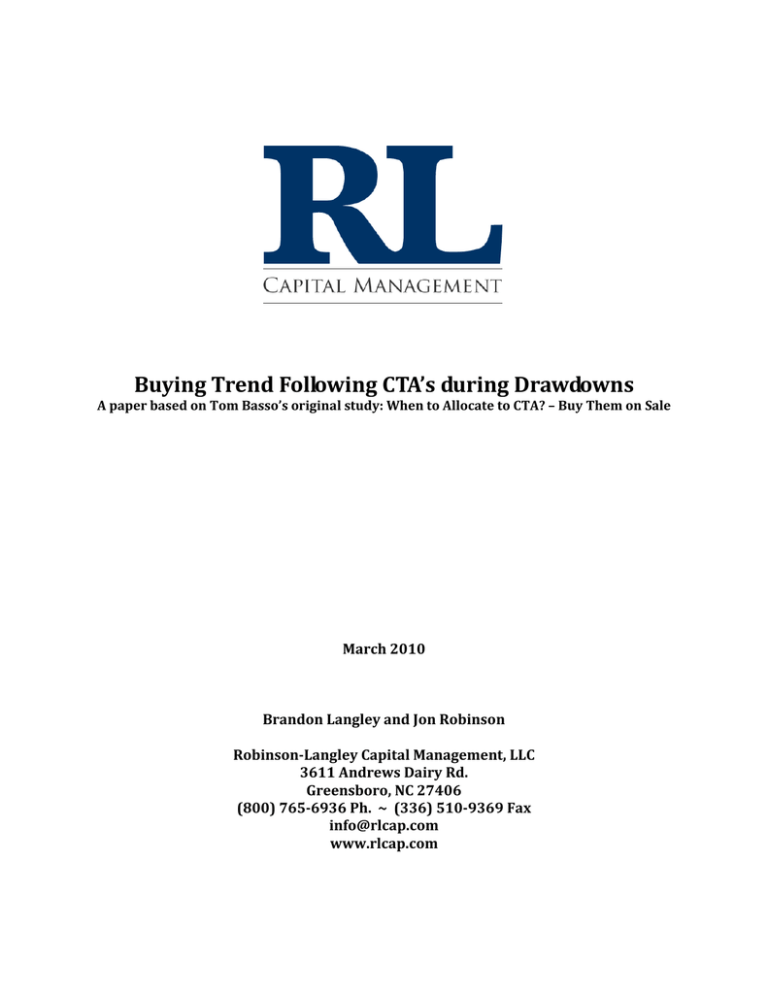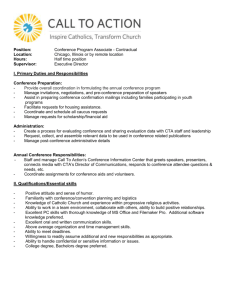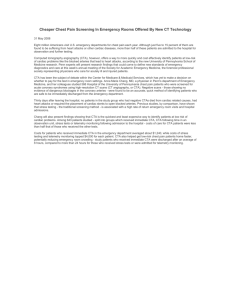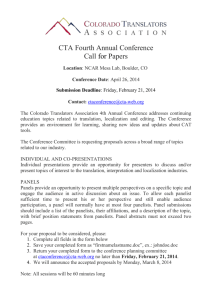Buying Trend Following CTA’s during Drawdowns
advertisement

Buying Trend Following CTA’s during Drawdowns A paper based on Tom Basso’s original study: When to Allocate to CTA? – Buy Them on Sale March 2010 Brandon Langley and Jon Robinson Robinson-Langley Capital Management, LLC 3611 Andrews Dairy Rd. Greensboro, NC 27406 (800) 765-6936 Ph. ~ (336) 510-9369 Fax info@rlcap.com www.rlcap.com Background As trend followers experience drawdowns, the natural inclination for most investors is to develop feelings of anxiety and question the viability of systems and sometimes the efficacy of trend following altogether. As systematic traders, we naturally feel inclined to provide the client or interested party with data in order to lend perspective to the current environment as well as place the current volatility in some historical context. Searching for insightful ways to display this data led us to a study produced by Tom Basso originally in January of 1997 entitled “When to Allocate to CTA? - Buy them on Salei”. Basso’s study deals with some of the statistics and psychological issues in buying a manager in a drawdown. This report seeks to take the framework from Basso’s study, apply it to trend following, and compare conclusions. Key Differences While the methodology of this study in relation to Basso’s is the same, our study focuses on trend followers only. This is done for a couple of simple reasons. First, we understand trend following, and feel that the same advantages exist to buying periods of negative performance. While this study is not a recommendation to buy or sell any specific trend following program, it may be used as empirical evidence within a prospective investor’s decision-making process. Therefore, we could not, in good faith, display a series of data points leading to a conclusion for a strategy that we did not completely understand and have full confidence in. Second, as a group, trend followers appear to have the most extensive track records in the CTA universe. This allowed us to collect a large enough data sample to make the study conclusive while maintaining a large breadth of individual CTA performance data. Details of the Study As with Basso’s study, we begin with a proprietary product, the RL Capital Managed Account Program. The intent of this study is to observe the edge, if any, in buying negative 3 month trailing returns. As of the end of February 2010, the program has experienced 22 3-month rolling periods with at least 12 months of subsequent performance. The data is plotted on Graph 1-1 below. The data in the northwest quadrant pertains to the situation in question; negative trailing 3-month returns coupled with a positive return over the subsequent 12 months. As the graph shows, there are 6 occurrences where this is the case vs. 2 occurrences where buying a negative 3-month period would have resulted in a negative return over the next 12 months (southwest quadrant). In this sample, the ratio of northwest to southwest quadrants is 6 to 2 or 3 to 1. Therefore, at least historically, an edge exists in buying the program in the midst of a 3-month drawdown. Graph 1-1 RL Capital Managed Account Program 80% NW NE 70% 60% Next 12 Months Return 50% 40% 30% 20% 10% 0% -15% -10% -5% 0% 5% 10% 15% 20% 25% 30% 35% -10% SW SE -20% 3 Month Trailing Return Past performance is not indicative of future results. 1 Larger Universe of Trend Followers: To further validate this conclusion, we used data from CTA ranking sites IASG, managedfutures.com, Autumn Gold and BarclayHedge. The list of CTA’s was filtered down by selecting Trend Followers with at least a 3-year track record and minimum $5M in assets. In our view, the track record threshold was more representative of a CTA’s longevity than AUM, thus in our opinion a greater predictor of CTA durability and long-term cash flow potential. This screening process produced 32 CTA’s yielding 4,469 data points with some track records going back as early as 1983. Again, similar conclusions are drawn. As the graph shows, there are 1,393 occurrences where a negative trailing 3-month period was followed by subsequent profitable 12-month period. On the other hand, a negative trailing 3-month drawdown would have resulted in a loss over the next 12 months 301 times for ratio of 4.6 to 1. The balance of the data points (2,091) fall in the northeast quadrant indicating a positive return on both a trailing 3-month and forward 12-month basis. Graph 1-2 CTA Database - Trend Followers over $5M AUM / Greater than 3-year Track Record 400% NW NE 350% 300% Next 12-Months Return 250% 200% 150% 100% 50% 0% -100.0% -50.0% 0.0% 50.0% 100.0% 150.0% 200.0% 250.0% -50% SW SE -100% 3-Month Trailing Return Past performance is not indicative of future results. How About Pulling Money after Good Performance? After seeing the edge produced by buying a period of negative performance, one might presume that the inverse might be true as it relates to selling positive performance. However, the reverse of buying drawdowns doesn’t seem to follow in the statistics. First, notice the overall center of distribution for the data points in the northeast quadrant (positive 12-month return after positive 3-month return). Second, on the right (east) quadrants of the Graph 1-2, there are 2,091 data points in the northeast and 684 in the southeast. This means that investors would have had a 3 to 1 chance of 12 months profits following a 3-month rolling period of profits. Again, the primary conclusion of this study is unchanged. While the overall distribution shows the positive edge associated with simply including the selected trend following firms in a balanced portfolio, the odds of positive 12-month performance are decidedly greater after a period of negative performance. Past performance is not indicative of future results. 2 Going a Step Further For additional insight, we changed the parameters to look at the robustness of this strategy. Adjusting the look back period to 6-months and the forward performance period to 18 months, we can see in Graph 1-3 a similar pattern. Of the 4,119 data points collected in this sample, 1,091 fall in the northwest quadrant while 156 fall in the southwest quadrant giving an impressive edge of buying the 6-month drawdown of 7 to 1. The larger edge using a longer term window comes as no surprise as many trend followers find their performance edge in longer time frames such as 12-24 months. Graph 1-3 CTA Database - Trend Followers over $5M AUM / Greater than 3-year Track Record 400% NW NE 350% 300% 250% Next 18-Months Return 200% 150% 100% 50% 0% -100.0% -50.0% 0.0% 50.0% 100.0% 150.0% 200.0% 250.0% -50% SW SE -100% 6-Month Trailing Return Past performance is not indicative of future results. Assumptions As with most manager performance tests, survivorship bias is the main cause for concern when gauging the efficacy of the data. Survivorship bias deals with the fact that studies such as this one are composed only from managers still in business. Thus, managers that have gone out of business due to poor performance whether over 3 months or 12 months are excluded. Like Basso, we will make two assumptions and let the investor decide whether the results are valid or not. First, we assume that the firms making up this study will continue to execute the trend following approach producing these past results and thus improve their odds of staying in business. The second assumption is the trend followers making up this study will produce a profit over the long run. Filtering the CTA’s included in the study by length of track record is intended to minimize the odds of ruin. As Basso states, “Buying into a drawdown doesn’t make much sense if the CTA is not going to be around in 12 months or that he/she is not likely to ever produce a long-term profit for the investor. But, what investor has ever invested in a CTA believing the CTA would disappear or produce losses. I would guess these assumptions would not be a problem to most in the real world.” Past performance is not indicative of future results. 3 Psychological Challenges So why don’t more investors seek to use drawdowns as buying opportunities, especially considering that most managers of established firms wait specifically for periods of down performance to invest more of their own funds in these strategies. We agree with Basso’s assertion that the answer lies in human psychology. Our minds tend to place more weight on recent events rather than look at the whole of performance with an equal distribution. Thus, investors may overweight their decision process towards speculating how long until a 1020% drawdown turns into a 50%+ drawdown, rather than evaluating the catalysts behind periods of negative performance and whether a favorable skew in odds is created towards achieving stronger performance going forward. Investors may also begin to look at the ‘hot’ investments of the moment, rather than stick with a diversified approach consistent with modern portfolio theory. Studies such as Basso’s and this one will hopefully provide psychological support to investors who have previously feared drawdowns. The Bottom-Line to Investors Basso’s statistics presented a decade ago are just as relevant now as then. In our view, the odds of making a positive return after a period of negative performance in an established trend following program are higher than after a period of positive performance. If an investor can utilize proper due diligence and find a manager that provides a good fit with their objectives, buying drawdowns will result in better performance and build client satisfaction. A client of Basso provides the best conclusion to the information presented, “I like to look for a [manager] that’s a quality operation, then wait ‘till I can buy them on sale.” --------------------------------------------------------------------------------------------------------------------------------------------------- About RL Capital RL Capital is a global alternative asset manager which specializes in the development of systematic investment strategies. Our philosophy is that above-average absolute and risk-adjusted returns can be best achieved by employing rigorously tested quantitative models across a broad range of markets. Utilizing models which invest in global futures and commodity markets as well as stocks allows for exposure to several non-correlated instruments aimed at providing a superior risk/reward tradeoff. Robinson-Langley Capital Management, LLC is registered with the Commodity Futures Trading Commission (CFTC) as a commodity trading advisor (CTA) and commodity pool operator (CPO) and a member of the National Futures Association (NFA) in such capacities. Current product offerings include the RL Capital Managed Account Program and a privately offered commodity pool. In addition, RL Capital has designed trading systems utilized by various traditional and alternative asset managers. Disclaimer This report is produced by Robinson-Langley Capital Management, LLC. (“RL Capital”). Opinions expressed here adapt quickly and without notice to changing market conditions. RL Capital is under no obligation to update any of this information. The information we use is obtained from sources we believe to be accurate; however, we make no guarantees in this regard. The information here does not constitute a recommendation to buy or sell anything and should not be considered by anyone to be a substitute for their own judgment. Futures and options trading involves substantial risk and is not suitable for every investor. RL Capital is the manager of the RL Capital Managed Account Program. Important information about the program including risks, objective, strategy and fees is contained in the program’s Disclosure Document. This is not and may not be used as a solicitation. No investment should be made without carefully reviewing the advisor’s disclosure document. Past performance is not indicative of future results. i http://www.intercontilimited.com/mfutsarchive/HedgeFunds/allocate2ctawhendown.pdf 4




